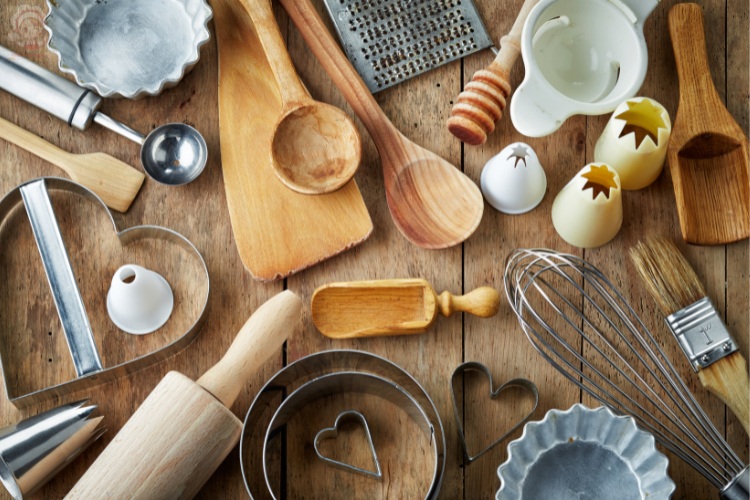Food preparation is the primary function of any kitchen, and it is impossible to accomplish without the appropriate kitchen utensils. However, what precisely are kitchen utensils, and how can you ensure you possess the suitable ones to meet your cooking requirements? Continue reading to discover with Foods for day to know what kitchen utensils are below.
1. What is the utensil’s meaning?
The meaning of utensils refers to tools or instruments, typically handheld, that are used for various purposes in the kitchen or during meals. Utensils serve specific functions in food preparation, cooking, serving, and consuming meals. They can include a wide range of items such as knives, spoons, forks, spatulas, tongs, whisks, ladles, peelers, graters, and many more. Utensils are essential for performing tasks like cutting, stirring, mixing, serving, and transferring food. Their purpose is to facilitate and enhance the efficiency and convenience of culinary activities.
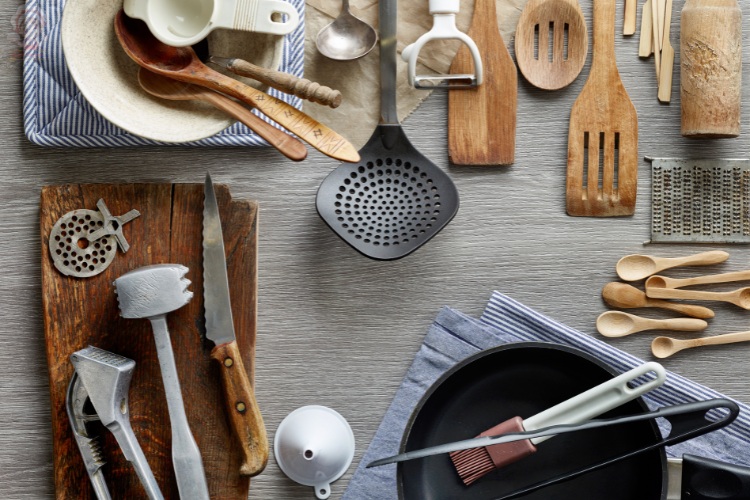
2. How to distribute kitchen utensils
Kitchen utensils encompass a range of items, including bakeware, cookware, and ovenware. All kitchen utensils fall under the category of kitchenware, as they are used in the kitchen to aid in various culinary tasks. Here are the different types of kitchen utensils:
Bakeware:
Bakeware refers to utensils specifically designed to assist with baking tasks. It comprises devices that hold ingredients during the baking process, such as casserole dishes and baking sheets. The primary function of bakeware is to provide a vessel for holding ingredients while they undergo baking. Some commonly encountered types of bakeware include:
- Baking pan: This type of bakeware is used to contain liquid batter as it thickens while baking in the oven. Baking pans are typically constructed from stainless steel, similar to other kitchen utensils like pots and pans, due to their non-stick and durable qualities.
- Bundt pan: Unlike casserole dishes or mixing bowls, a bundt pan is primarily crafted from stainless steel and imparts a round shape with a hollow center to the liquid batter.
- Loaf pan: This deep dish bakeware is employed for baking liquids in the form of a loaf. Stainless steel loaf pans offer durability and prevent burning, unlike glass casserole dishes or loaf pans.
- Springform pan: Designed to shape ingredients into a round cake form, a springform pan is equipped with a removable bottom. Springform pans are commonly manufactured using stainless steel to prevent burning, unlike glass pans.
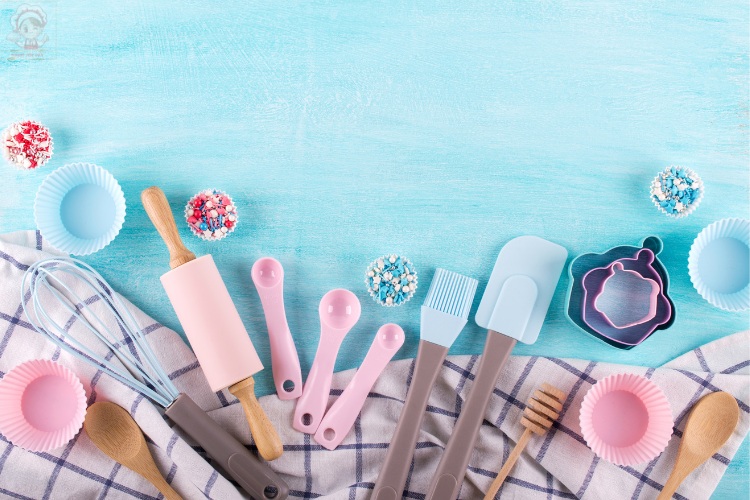
Cookware:
Cookware encompasses utensils utilized to facilitate cooking tasks, such as grilling or frying ingredients. The primary function of cookware is to hold ingredients during the cooking process. Some widely used types of cookware include:
- Frying pan: A type of cookware that transfers heat from a cooktop to the ingredients placed in the pan. Frying pans can be made of aluminum or stainless steel, with stainless steel being the preferred material for its durability and resistance to burning or scratching.
- Stockpot: A large, round pot with a flat bottom employed for boiling stock or broth ingredients. Stockpots are commonly crafted from carbon steel materials coated with a non-stick enamel to prevent ingredients from burning.
- Wok: A circular-shaped frying pan typically made of carbon steel, which provides a non-stick and durable surface unlike traditional metal frying pans.
- Saute pan: A frying pan with straight sides, often constructed using stainless steel materials to prevent burning and the escape of liquids.
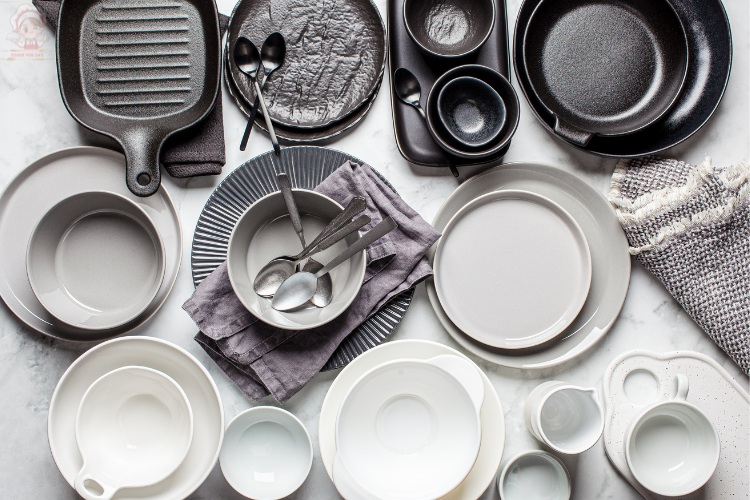
Ovenware:
Ovenware pertains to utensils intended for tasks carried out in the oven, such as baking or cooking casserole dishes. The primary function of ovenware is to transport and cook food within the oven. Some types of ovenware include:
- Dutch oven: a heavy-duty cooking pot equipped with a lid, usually made of seasoned cast iron. Dutch ovens are typically heavier than other cookware or ovenware options.
- Baking dish: a rectangular-shaped dish used for baking in the oven. Baking dishes are commonly crafted from glass, which heats up gradually but prevents ingredients from burning.
- Pizza stone: a flat utensil placed directly on the oven rack to transfer heat to the pizza. Pizza stones are often made of ceramic or stone, facilitating optimal heat distribution.
- Roasting pan: a large, oven-safe pan employed for roasting. Roasting pans are typically made with thick stainless steel or glass to withstand the weight of the food being roasted.
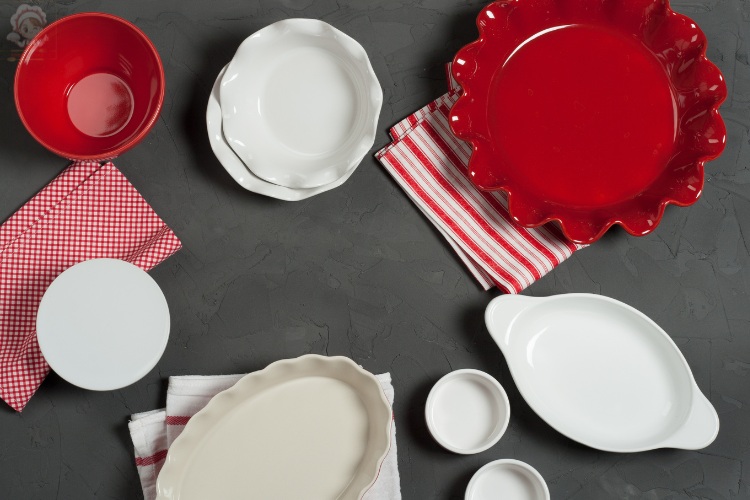
These are the various types of kitchen utensils classified as bakeware, cookware, and ovenware, each serving a specific purpose in assisting with cooking and baking tasks.
3. What are the kitchen utensils used for?
Kitchen utensils serve the primary purpose of aiding in various kitchen tasks. Here are several common applications of kitchen utensils:
- Stirring: Use cookware, such as pots or pans, to stir ingredients while cooking, such as soups or sauces.
- Frying: Utilize cookware like a frying pan to fry ingredients.
- Baking: Employ ovenware to heat and cook casseroles in the oven.
- Preparation: Use utensils for preparing ingredients, including cutting, chopping, and other food preparation tasks.
- Boiling: Boil liquids, such as soup or pasta sauces, using specialized boiling utensils.
- Scooping: Utilize utensils for scooping and serving ingredients.
- Roasting: Use cooking utensils, like those specifically designed for roasting, to roast meats such as chicken or beef.
- Baking desserts: Employ bakeware, such as pans for cakes or pies, to bake delicious desserts.
The material composition of each kitchen utensil affects its range of uses. Cookware is typically crafted from stainless steel materials, making it versatile for various cooking tasks. Bakeware is commonly made from aluminum and is designed for use inside the oven. Ovenware, also made from aluminum, is specifically intended for baking rather than stovetop cooking.
These different kitchen utensils and their respective materials cater to specific cooking needs, making the culinary experience more efficient and enjoyable.
Please refer to the following video showcasing the most commonly used kitchen tools:
4. What are the time-saving benefits of using kitchen utensils?
- Kitchen utensils are essential for saving time during various cooking tasks, including preparation, boiling, baking, and cooking. These utensils efficiently reduce the time required to prepare and cook different ingredients.
- For instance, when used as cookware, a frying pan can expedite the process of frying an egg compared to using bakeware. Frying an egg in a pan typically takes only 2-3 minutes on medium heat, whereas using bakeware requires around 5-6 minutes at 425 degrees.
- When utilized as ovenware, a casserole dish can significantly reduce the baking time for pasta dishes. While it is possible to cook pasta in a saucepan, it usually takes around 30 minutes and may result in burned ingredients. Conversely, a casserole dish can efficiently cook the ingredients in approximately 20 minutes, ensuring consistent and even heating.
- As bakeware, muffins baked on a baking sheet can take around 30-40 minutes. However, using a muffin pan not only reduces the baking time to 15-20 minutes but also helps in achieving a well-formed muffin shape.
- By employing the right kitchen utensils for specific tasks, cooks can effectively save time and streamline the cooking process, allowing for more efficient meal preparation.
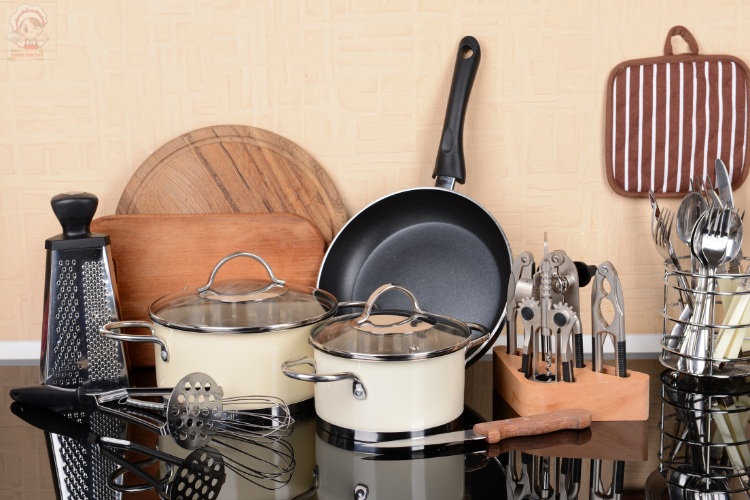
5. What are a handful of alternative expressions for kitchen utensils?
Kitchen utensils are known by various names, encompassing a range of related terms. Some alternative terms used to refer to kitchen utensils include:
- Housewares: Housewares encompass a broad category of household items, including kitchen utensils and tableware. It represents a larger group of items utilized within a household.
- Cookware: Cookware specifically denotes a subset of kitchen utensils designed for cooking purposes. It is a distinct type of kitchen utensil.
- Bakeware: Bakeware refers to a specific category of kitchen utensils employed in baking tasks. It falls under the umbrella of kitchen utensils.
- Ovenware: Ovenware refers to a particular subset of kitchen utensils intended for cooking tasks performed in an oven. It is considered a type of kitchen utensil.
While these terms highlight subcategories of kitchen utensils, they are frequently used interchangeably to describe tools employed in the kitchen. Additionally, a kitchen utensil can also be referred to as a kitchen tool. However, it is important to note that the term “kitchen tool” can also encompass tools such as screwdrivers or hammers that are used specifically within the kitchen context.
The origins of cooking utensils can be traced back to the Stone Age, when individuals utilized mortar and pestle to prepare and create meals. While kitchen utensils have undergone numerous transformations since that time, contemporary utensils are primarily crafted from stainless steel materials.
A utensil refers to a handheld instrument employed for the preparation or consumption of food. The primary objective of kitchen utensils is to aid in various culinary tasks such as serving, cutting, chopping, and mixing. Certain kitchen utensils also serve as eating utensils, including forks, spoons, and knives, enabling the transfer of food from a plate or bowl to the mouth.
Foodsforday is the founder of the Foods For Day blog. A lover of cooking, sharing and synthesizing cooking experiences on recipes, kitchen utensils, and spices.
